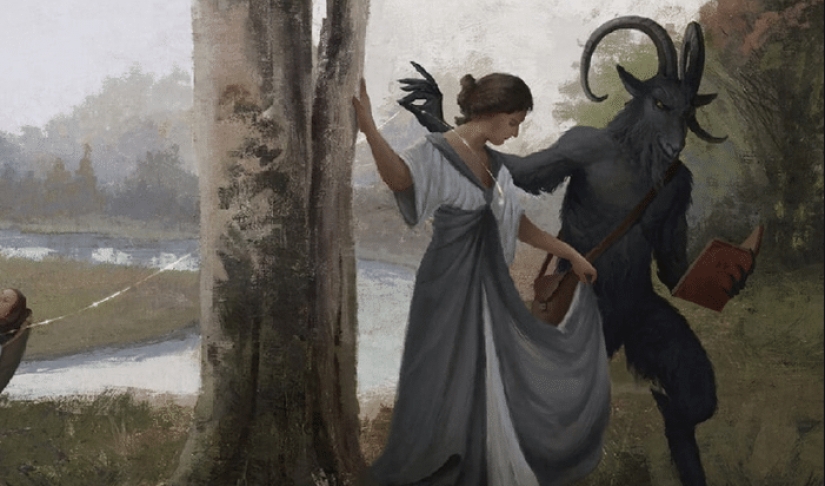Why is the devil depicted with horns and hooves
By Pictolic https://pictolic.com/article/why-is-the-devil-depicted-with-horns-and-hooves.htmlDevils are traditionally depicted with horns, hooves and tails. Sometimes a pig's piglet and wings are added, as well as thick fur all over the body. Why did they choose this kind of evil for evil spirits? Is it really just for intimidation? Let's figure out exactly how the devil got his unusual attributes.

The animal parts that the devil was endowed with were supposed to symbolize his bestial essence, opposed to human. As you know, God created the first man in his own image and likeness. It would be strange to see an enemy of the human race with the same appearance. Evil should look ridiculous, absurd, repulsive.

Elements from different mammals and birds collected in one creature were supposed to emphasize its phantasmagoricity and absurdity. But why are horns and hooves chosen, and not, for example, a duck beak and fish eyes? Let's dive into the history of religion and find out this moment.
In the religions common in the pre-Christian era, many deities were endowed with horns. The growths on the head symbolized fertility and connection with nature. The most famous horned god was Pan, who was also accompanied by horned satyrs. Scientists believe that these are echoes of more ancient times, when people worshipped animals, for example, a bull.

The pagan gods Moloch and Baal were also depicted as bulls. The people who believed in them persecuted the Jews, causing them quite logical dislike. Christians inherited it from the Jews and the horns began to personify everything bad and hostile to people. Pre-Christian gods became the prototype of the devil, including Pan, who also had a beard and pointed ears.
Still at In the Middle Ages, devils and the King of Darkness himself were depicted with webbed wings. They were like two drops of water like the wings of bats, which had a bad reputation since ancient times. People turned on flying mammals because of their secretive, nocturnal lifestyle and those leathery upper limbs. The repulsive wings of evil spirits were contrasted with the white wings of angels made of feathers and down.

Dante Alighieri in The Divine Comedy described the devil as a huge demon, behind which three pairs of webbed wings were located at once. The image of Satan is far from human, although later attempts were made to make him more like people. Milton in Paradise Lost gave him a certain romantic charm, but this did not affect the established image.
The hooves of devils are not in all images. Sometimes evil spirits are depicted with clawed paws. Researchers are sure that hooves, as well as horns with a beard, became the legacy of the ancient god Pan and fauns. The first Christians found the cult of Pan, so they were well acquainted with his appearance. Only the god of shepherding and cattle breeding hooves symbolized his patronage of hoofed animals, and not evil at all.

Most often devils were endowed with goat hooves. This animal is not particularly attractive, smells bad and, most importantly, has long sharp horns and a beard. Satan was often depicted as a goat, giving the animal some human features, for example, adding his face and hands.
The fur—covered body is another legacy of Pan and fauns. In most cases, the devil is covered with long, disheveled goat hair. But there are exceptions. In Lithuania, for a long time, the devil has been portrayed as a well-groomed dandy who pays a lot of attention to appearance. In later versions, evil spirits may even appear in the form of a dandy, whose fur is hidden by a tailcoat. Sometimes only small horns under the hat and a tail, which may appear out of the trousers quite out of place, give out the devil.

Pan was not the only pre-Christian deity who influenced the image of the devil. He borrowed something from Neptune. Remember the pitchforks that are traditional for the inhabitants of Hell. With the help of this peasant tool, it is very handy to throw sinners into frying pans and boilers. But this is nothing but the trident of the god of the seas and oceans — the tools of hunters for big fish and sea animals.
It turns out that the gods of the old religions become the demons of the new ones. This is natural, otherwise how can people be forced to renounce those to whom they have turned for centuries for help. Mermaids, devils, water, goblins — all these representatives of ancient beliefs have turned into enemies of the human race. Although in some folk tales it is still possible to catch a benevolent attitude towards evil spirits. It happens that she helps the main character in his mission and even causes some sympathy.

Did you know that in the Middle Ages devils and demons were often depicted with faces between their legs? And there is also quite a logical explanation for such symbolism.
Recent articles

American artist Mike Leavitt (Mike Leavitt) - a big fan of movies. To pay tribute to his favorite directors, he made 16 small ...

Artist Yet master of different genres — historical painting, portraits, mythological subjects, — where a celebration of ...

At a time when there was no Internet, television, and tourist opportunities were limited, people had ideas about other peoples from ...